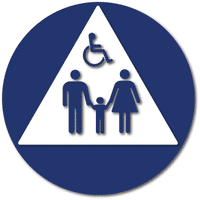
California Title 24 Compliant Restroom, Bathroom, Shower Room Door Signs
California Title 24 Compliant Restroom Door Signs
While most states require only an ADA compliant restroom sign with tactile text and braille beside a restroom door, California requires an additional sign on the door of all restrooms and sanitary facilities. These Title 24 compliant restroom door signs have become commonly used in many other states, even when not technically required for ADA compliance. The reason is simple: Restroom/Bathroom Door Signs are extremely practical. The geometric shaped California door signs (circle for women, triangle for men, triangle on circle for unisex/gender neutral) can be used for all sanitary facilities. These door signs make it easy and immediate to identify and distinguish between a men-only restroom or shower, a women-only bathroom or shower, or a unisex restroom for families, or any gender designation for bathrooms, showers, or locker rooms or nursing/maternity rooms.
At ADA Sign Depot, we manufacture high quality California compliant and ADA compliant restroom signs in a array of materials and colors, including our beautiful line of Brushed Aluminum Restroom Signs. You can order our restroom signs on this website 24/7, or place your order with us by phone: 858.385.9095. (Curious how California's Triangle and Circle Door Signs came about? Scroll to the bottom of this page to read about Sam Genesky, the inventor.)
![]() Beverly R., Washington
Beverly R., Washington
"The website is easy to use and when I sent an e-mail with a question, I received a reply very quickly which answered my question clearly."

Mens Accessible Bathroom Door ADA Signs with Text - 12" x 12"
ADA-1146

Unisex Family Wheelchair Bathroom Door Sign with Text - 12x12
ADA-1151
Question: Who Invented California Title 24 Circle and Triangle Restroom Door Signs?
Sam Genesky was American computer scientist best known as an inventor for devices to assist sight-impaired persons and his advocacy on behalf of the blind. In 1978 he founded the Center for the Partially Sighted, a Los Angeles facility with the mission to provide the tools and techniques that maximize the ability of partially sighted children and adults to live successful and independent lives.According to Wikipedia, Sam Genesky was also nearly blind.
When Genensky was born, the Commonwealth of Massachusetts had a requirement that all newborn babies receive drops of dilute silver nitrate in both eyes, to prevent the possible passage of syphilis from mother to child. He received the required drops, but unfortunately the chemical had not been diluted, and both his eyes were badly burned. Three months later he was treated by Dr. Frederick H. Verhoeff, a highly regarded specialist in ophthalmology, who performed partial iridectomy on both eyes (thinking that glaucoma would otherwise occur). The result of the burns and the iridectomies was complete loss of vision in Genensky's left eye and near-blindness in the right eye (the best he ever achieved in vision testing was 20/1000).Sam Genensky went on to earn a Master’s degree from Harvard and a Doctorate from Brown. After graduation he joined the RAND Corporation, where he headed the invention of CCTV closed circuit television) to help people of all ages, young and old, who still had some remaining vision but were not yet completely blind.
But what about those Triangle and Circle Restroom Door signs used in California and so many other states?
It is said that, “Necessity is the mother of invention.”And it was necessity that led Sam Genensky’s to inventing what is now known as California Title 24 Geometric Restroom Door Signs.
In the 1970's, while Dr. Sam Genensky was working for the RAND Corporation located in Santa Monica, California, he had some awkward experiences looking for a bathroom. The signs marking the restrooms were too small for him to read unless he put his face right up to the door. Sometimes the door he was peering at turned out to the wrong door, and he would startle a woman coming out.
When a Rand security guard asked the scientist why he was “smelling restroom doors," Genensky resolved to solve the problem.
As Paul Baran, a scientist and colleague of Genesky’s at Rand has stated, "He's the guy responsible for the triangle and circle," referring to the widely adopted system of a triangle-shaped sign to identify the men's room and a circle-shaped one for the women's room.
Genensky's “geometry” eventually became the standard for marking public restrooms in California. At first, just the geometric symbols were used. Later, expanding the attempt to make restrooms accessible for everyone, designers and sign makers added pictograms to represent Men and Women and Unisex restroom signs. Other states began to follow the example set by California. Then in 1990, the Americans With Disabilities Act (ADA) became the law of the land, creating Federal standards for restrooms.
But the authors of the ADA chose not to adopt the established door symbols already in use in California and other states. Instead, they developed a Wall sign adjacent to the door and used raised pictograms and braille. Other standards were created as to size, mounting and accessibility requirements. Restrooms were required to become accessible to wheelchairs and the new International Symbol of Accessibility (ISA) was required to be posted.
Thank you, Sam Genesky!



















































